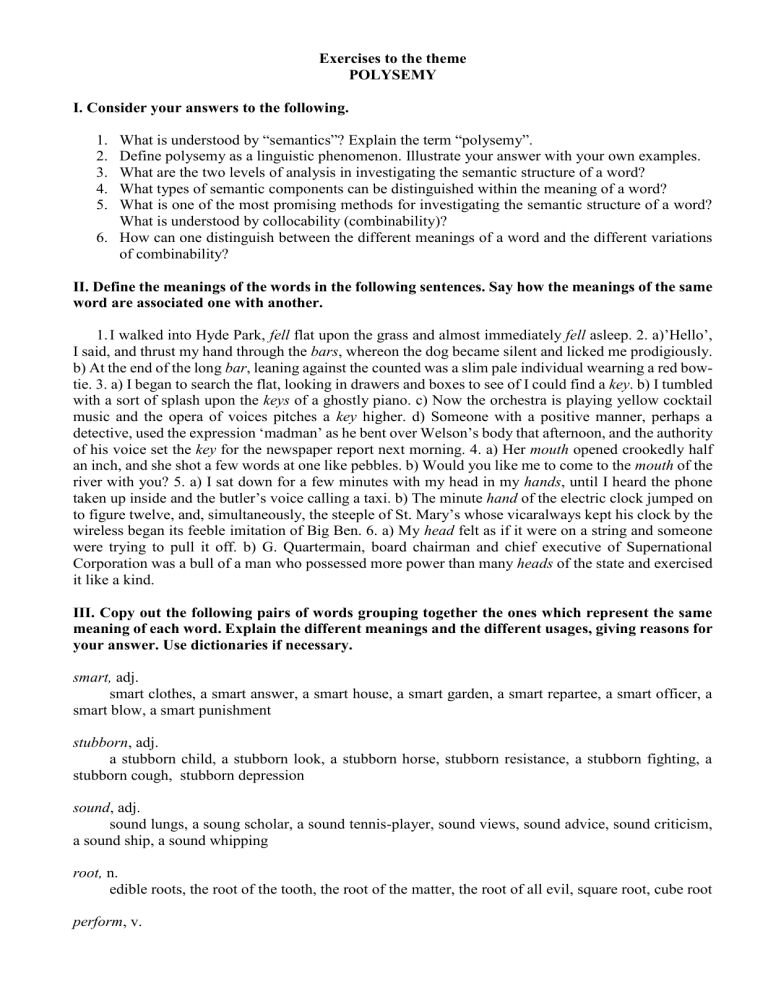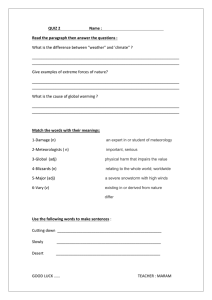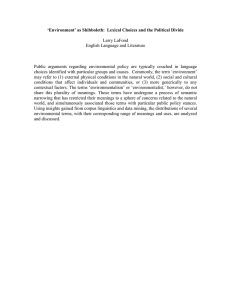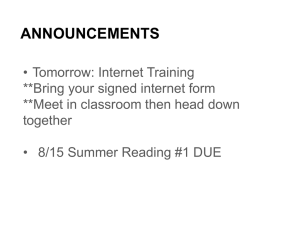
Exercises to the theme POLYSEMY I. Consider your answers to the following. What is understood by “semantics”? Explain the term “polysemy”. Define polysemy as a linguistic phenomenon. Illustrate your answer with your own examples. What are the two levels of analysis in investigating the semantic structure of a word? What types of semantic components can be distinguished within the meaning of a word? What is one of the most promising methods for investigating the semantic structure of a word? What is understood by collocability (combinability)? 6. How can one distinguish between the different meanings of a word and the different variations of combinability? 1. 2. 3. 4. 5. II. Define the meanings of the words in the following sentences. Say how the meanings of the same word are associated one with another. 1. I walked into Hyde Park, fell flat upon the grass and almost immediately fell asleep. 2. a)’Hello’, I said, and thrust my hand through the bars, whereon the dog became silent and licked me prodigiously. b) At the end of the long bar, leaning against the counted was a slim pale individual wearning a red bowtie. 3. a) I began to search the flat, looking in drawers and boxes to see of I could find a key. b) I tumbled with a sort of splash upon the keys of a ghostly piano. c) Now the orchestra is playing yellow cocktail music and the opera of voices pitches a key higher. d) Someone with a positive manner, perhaps a detective, used the expression ‘madman’ as he bent over Welson’s body that afternoon, and the authority of his voice set the key for the newspaper report next morning. 4. a) Her mouth opened crookedly half an inch, and she shot a few words at one like pebbles. b) Would you like me to come to the mouth of the river with you? 5. a) I sat down for a few minutes with my head in my hands, until I heard the phone taken up inside and the butler’s voice calling a taxi. b) The minute hand of the electric clock jumped on to figure twelve, and, simultaneously, the steeple of St. Mary’s whose vicaralways kept his clock by the wireless began its feeble imitation of Big Ben. 6. a) My head felt as if it were on a string and someone were trying to pull it off. b) G. Quartermain, board chairman and chief executive of Supernational Corporation was a bull of a man who possessed more power than many heads of the state and exercised it like a kind. III. Copy out the following pairs of words grouping together the ones which represent the same meaning of each word. Explain the different meanings and the different usages, giving reasons for your answer. Use dictionaries if necessary. smart, adj. smart clothes, a smart answer, a smart house, a smart garden, a smart repartee, a smart officer, a smart blow, a smart punishment stubborn, adj. a stubborn child, a stubborn look, a stubborn horse, stubborn resistance, a stubborn fighting, a stubborn cough, stubborn depression sound, adj. sound lungs, a soung scholar, a sound tennis-player, sound views, sound advice, sound criticism, a sound ship, a sound whipping root, n. edible roots, the root of the tooth, the root of the matter, the root of all evil, square root, cube root perform, v. to perform one’s duty, to perform an operation, to perform a dance, to perform a play kick, v. to kick the ball, to kick the dog, to kick off one’s slippers, to kick smb. downstairs IV. The verb “to take” is highly polysemantic in Modern English. On which meanings of the verb are the following jokes based? Give your own examples to illustrate the other meanings of the word. 1. “Where have you been for the last four years?” “At college taking medicine.” “And did you finally get well?” 2. “Doctor, what should a woman take when she is run down?” “The license number, madame, the license number.” 3. Proctor (exceedingly angry): So you confess that this unfortunate Freshman was carried to this frog pond and drenched. Now what part did you take in this disgraceful affair? Sophomore (meekly): The right leg, sir. V. Explain the basis for the following jokes. Use the dictionary when in doubt. 1. Caller: I wonder if I can see your mother, little boy. Is she engaged? Will: Engaged! She’s married. 2. Booking Clerk (at a small village station): You’ll have to change twice before you get to York. Villager (unused to traveling): Goodness me! And I’ve only brought the clothes I’m wearing. 3. The weather forecaster hadn’t been right in three months, and his resignation caused little surprise. His alibi, however, pleased the city council. “I can’t stand this town any longer,” read his note, “The climate doesn’t agree with me.” 4. Professor: You missed my class yesterday, didn’t you? Unsubdued student: Not in the least, sir, not in the ;east. 5. “Papa, what kind of a robber is a page?” “A what?” “I says here that two pages held up the bride’s train.” VI. Choose any polysemantic word that is well-known to you and illustrate its meanings with examples of your ow. Prove that the meanings are related one to another. VII. Read the following jokes. Analyse the collocability of the italicized words and state its relationship with the meaning. 1. Lady (at party): Where is that pretty maid who was passing our cocktails a while ago?\ Hostess: Oh, you are looking for a drink? Lady: No, looking for my husband. 2. Peggy: I want to help you. Dad. I shall get the dress-maker to teach me to cut out gowns. Dad: I don’t want you to go that far, Peg, but you might cut out cigarettes, and taxi bills. 3. There are cynics who claim that movies would be better if they shot less films and more actors. 4. Kitty: Is your wound sore, Mr. Pup? Mr. Pup Wound? What wound? Kitty: Why, sister said she cut you at the dinner last night. VIII. Try your hand at being a lexicographer. Write simple definitions to illustrate as many meanings as possible for the following polysemantic words. After you have done it, check your results using a dictionary. Face, heart, nose, smart, to lose. IX. Try your hand at the following research work. a. Illustrate the semantic structure of one of the following words with a diagram; use the dictionary if necessary. Foot, n.; hand, n.; ring, n.; stream, n.; warm, adj.; green, adj.; sail, n.; key, n.; glass, n.; eye, n. b. Identify the denotative and connotative elements of the meanings in the following pairs of words. To conceal – to disguise, to choose – to select, to draw – to paint, money – cash, photograph – picture, odd – queer. c. Read the entries for the English word “court” and the Ukrainian «суд» in an EnglishUkrainian and Ukrainian- English dictionary. Explain the differences in the semantic structure of both words.


